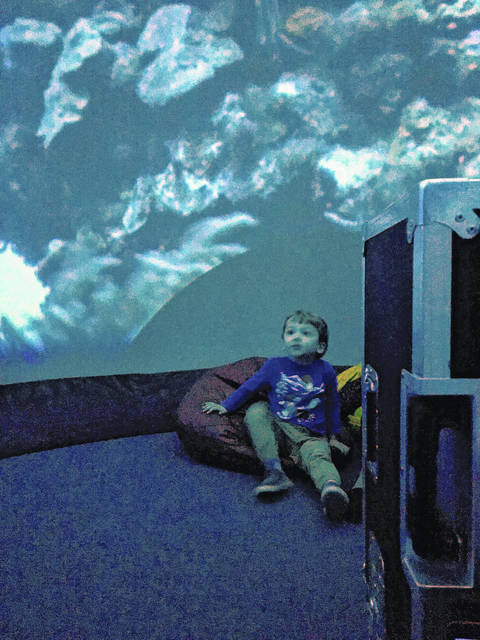Solar systems, constellations and coral reefs captivated the attention of children and adults at the final day for the StarLab Friday at Hampton B. Allen Library.
Participants gathered in the all-black, inflatable dome to view a 360-degree projection of the videos.
The first video allowed viewers to tour the stars and planets through a telescope. The video focused on the history of telescopes, and how it has helped astronomers make various developments in their study of space.
In the darkened “room,” the stars shone bright around the inner dome, giving the audience the full visual effects of being in space. The awe of the projections filled the dome, as the children watched the developments of the galaxy.
For most of the video, curiousity reigned throughout the children, leaving them verbalizing their observations. Later, after the video went on, they stared in amazement, as “cool” and “ahs” filled the dome.
“The fish eye projector and StarLab dome helped transport the viewer to each location making us all feel we had traveled from the edge of the universe all the way to a coral reef in Belize,” said Caroline Hightower.
The coral reef video gave the underwater view, as fish swam around the camera. A short video of a giraffe being fed lettuce, included moments of flinching as the giraffe came seemingly close to the camera. The chidren ducked as the giraffe appeared, seemingly inches from their faces.
“In addition to the movies about space, the teens and young children especially enjoyed the coral reef and giraffe movies,” she said.
The final video took viewers on a dizzying tour back through the galaxy, as they watched the stars form.
“We had positive feedback from both children and adults,” Hightower said. “The movies shown often sparked great curiosity which led to interesting questions about the stars, planets and the search for life in our universe and beyond.”
Many of the children and teens visited the StarLab multiple times throughout its visit to the library.
“It was a pleasure to host the StarLab here at our library and see the joy and curiosity on each person’s face,” she said. “While we would love for the StarLab to make another tour throughout the Sandhills Regional Library System, there are no plans that I am aware of at this time.”
The StarLab is part of a grant through the Institute for Museums and Library Services and the Library Services and Technology Act that the North Carolina Library needed to use. Four planetariums were purchased with the funds.
According to StarLab’s website, the planetarium elevates lessons in astronomy, history, earth sciences and mythology to a new level. It is 11 feet high and 23 feet in circumference. The dome weighs 65 pounds and can fit 30 to 40 children at one time.

Children of all ages can stare at the beauty of the coral reef in the StarLab, just as this youngster is doing.

StarLab features the projection of the galaxy.
